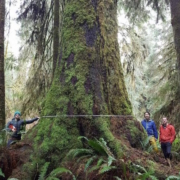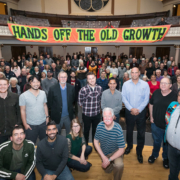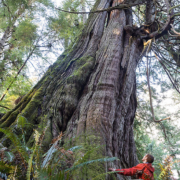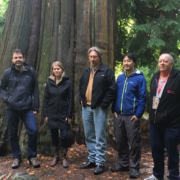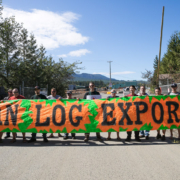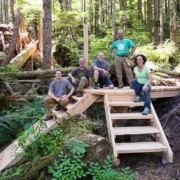Internationally-acclaimed artist Kelly Richardson moves to Victoria, turns attention to “Tall Trees Capital” of Canada – Port Renfrew
For Immediate Release
Tuesday, January 9, 2017
Victoria, BC – Vancouver Island’s famed old-growth forests near Port Renfrew – known as Canada’s “Tall Trees Capital” – have attracted the attention of internationally acclaimed artist Kelly Richardson, who will feature these ancient forests in an upcoming digital art installation to be projected on IMAX screens across the country as part of an upcoming large-format film series.
Richardson is known for creating hyper-real digital films of rich and complex landscapes that have been manipulated using CGI, animation and sound. Her projects have received major international acclaim, having been featured in the National Gallery of Canada, in galleries around the world, in an official Canada 150 exhibition this year, and in the upcoming large-format film series.
Taking cues from 19th century painting, 20th century cinema and 21st century scientific inquiries, Richardson creates works with strong environmental themes, asking viewers to consider what the future might look like if we continue on our current trajectory of planetary pillaging and consumption, and why we have allowed ourselves to arrive at such a moment of global environmental crisis.
Kelly Richardson said: “Having lived and worked in England for the last 14 years, I recently relocated to Victoria in order to be closer to the truly magnificent old-growth forests. After visiting Avatar Grove during a work trip in the fall of 2016, I was overwhelmed by my experience of those ancient stands, which was a huge influence in my decision to apply for a professorship at the University of Victoria where I now work. My upcoming projects will feature the old-growth forests in this region and I hope I can contribute to efforts to raise awareness about their outstanding beauty and the plight to protect what remains.”
Over the years, Vancouver Island’s old-growth forests have drawn considerable attention from the artistic community, including Emily Carr who produced pieces depicting the old-growth trees, giant stumps, and forests of the region (whose works in regards to her interest in ancient forests is currently on display in the Art Gallery of Greater Victoria.
) in the first half of the 20th century; scores of renowned artists who contributed to the best-selling art book “Carmanah: Visions of an Ancient Forest” (300,000 copies sold) in 1990; and increasing numbers of artists and filmmakers in recent years featuring the ancient forests around Port Renfrew, including Richardson.
“We’re excited to have such a renowned and original artist of Kelly Richardson’s caliber, focusing her talent to draw international attention through creativity to the endangered old-growth forests of Vancouver Island. Her work has gone far and wide across North America, Europe, and China, garnering major media attention, moving critics and reaching popular audiences, all while raising environmental themes in powerful ways”, stated Ken Wu, executive director of the Ancient Forest Alliance. “The old-growth forests around Port Renfrew – still largely endangered – are clearly continuing to impress increasing numbers of people – not only tourists, businesses, and news media, but acclaimed artists as well.”
Born in Canada, Kelly Richardson’s works have been widely acclaimed in North America, Asia and Europe, having been acquired by the National Gallery of Canada, Art Gallery of Ontario, and Musée d’art contemporain de Montréal in Canada and by museums around the world. Her video installations have been included in the Toronto International Film Festival, Sundance Film Festival and she was previously honoured at the Americans for the Arts National Arts Awards alongside Robert Redford, Salman Rushdie and fellow artist, Ed Ruscha. Her forthcoming work focusing on British Columbia’s old-growth forests will be featured in the upcoming XL-Outer Worlds Project, an exposition of five new large format films by five digital media artists, including Richardson, that will help highlight Canada’s invention of IMAX film technology, to be screened across the country in IMAX theatres in 2019.
Located only 20 minutes from Port Renfrew, the Avatar Grove or “T’l’oqwxwat” in the language of the local Pacheedaht First Nation, is home to one of the most spectacular and easily accessible stands of monumental old-growth trees in BC. It has become among the province’s most popular old-growth tourism destinations, attracting visitors from around the world (particularly with the completion of a boardwalk last August), the attention of countless national and international news media organisations, and a major investment in new businesses in the region.
The campaign to protect the grove, spearheaded by the Ancient Forest Alliance and the Port Renfrew Chamber of Commerce – a ground-breaking alliance of environmental activists and the local business community – has significantly fuelled a provincial movement of businesses, labour unions, city and town councils, and environmental groups calling on the British Columbian provincial government to protect old-growth forests and to ensure a sustainable, second-growth forest industry.
More BACKGROUND Information on artist Kelly Richardson
Kelly Richardson’s work has been acquired into significant museum collections across Canada, the UK, and the USA including the National Gallery of Canada, Art Gallery of Ontario, Musée d’art contemporain de Montréal, Hirshhorn Museum and Sculpture Garden (USA), Albright-Knox Art Gallery (USA), Arts Council Collection (England), among others. Recent one person exhibitions include Dundee Contemporary Arts, SMoCA, CAG Vancouver, VOID Derry, Naturhistorisches Museum Wien and a major survey at the Albright-Knox. Her work was selected for the Canadian, Beijing, Busan, Gwangju and Montréal biennales, and major moving image exhibitions including the The Cinema Effect: Illusion, Reality and the Moving Image at the Hirshhorn Museum and Sculpture Garden, Toronto International Film Festival and Sundance Film Festival.
Kelly Richardson was born in Burlington, Ontario, Canada. From 2003-2017 she resided in north east England where she was a Lecturer in Fine Arts at Newcastle University. She currently lives and works as a visitor on the traditional territory of the WSANEC peoples of the Coast Salish Nation on Vancouver Island, Canada. She is Associate Professor in Visual Arts at the University of Victoria. See her website at https://kellyrichardson.net
More BACKGROUND Information on BC’s Old-Growth Forests
Old-growth forests are vital to sustaining unique endangered species, climate stability, tourism, clean water, wild salmon, and the cultures of many First Nations. On BC’s southern coast, satellite photos show that at least 75% of the original, productive old-growth forests have been logged, including well over 90% of the valley bottoms where the largest trees grow. Only about 8% of Vancouver Island’s original, productive old-growth forests are protected in parks and Old-Growth Management Areas (see maps and stats at: https://16.52.162.165/ancient-forests/before-after-old-growth-maps/). Old-growth forests – with trees that can be 2000 years old – are a non-renewable resource under BC’s system of forestry, where second-growth forests are re-logged every 50 to 100 years, never to become old-growth again.
In recent times, the voices for old-growth protection have been quickly expanding, including numerous Chambers of Commerce, mayors and city councils, forestry unions, conservation groups, and First Nations across BC who have been calling on the provincial government to expand protection for BC’s remaining old-growth forests. The Ancient Forest Alliance is also calling on the province to support First Nations land use plans and the sustainable economic development and diversification of the communities as an alternative to old-growth logging. See a recent news article at: https://www.sookenewsmirror.com/news/groups-demand-protection-of-islands-old-growth-forests/
About the XL-Outer Worlds Project
Janine Marchessault of the Public Access Collective and Christian Kroitor (grandson of IMAX inventor Roman Kroitor) of True Frame Productions have come together to commission five new large-format digital film shorts in celebration of the 50th anniversary of the invention of IMAX. The theme for the commissioned program is in keeping with the cinematic genre typical of IMAX films: the larger-than-life landscape that forms an outer world. Participating Canadian media artists include: Oliver Husain, Lisa Jackson, Kelly Richardson, Michael Snow, and Leila Sujir. XL-Outer Worlds will result in a four-day Festival Celebration in 2019 at the Cinesphere, the world’s first permanent IMAX movie theatre located in Toronto at Ontario Place. This festival will showcase the commissioned films celebrating the invention of IMAX, alongside curated programs of early IMAX films. The XL-Outer Worlds festival will later tour the first IMAX cinemas across Canada in Victoria, Sudbury, Edmonton and Montreal. This is one of the 200 exceptional projects funded through the Canada Council for the Arts’ New Chapter program. With this $35M investment, the Council supports the creation and sharing of the arts in communities across Canada.


